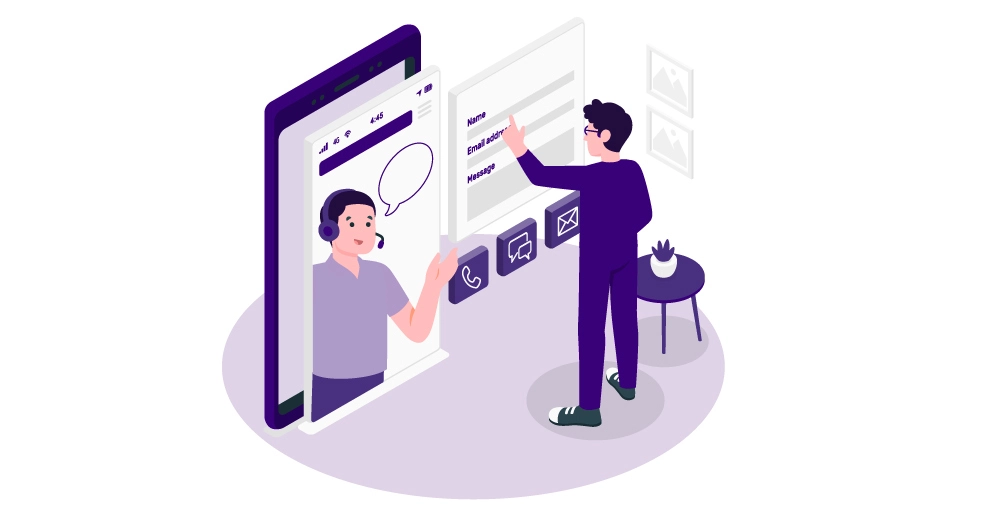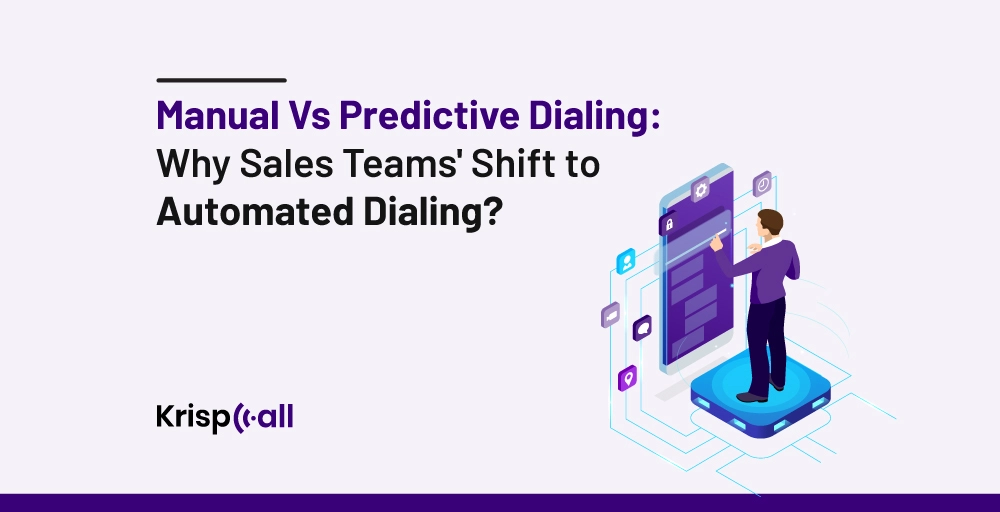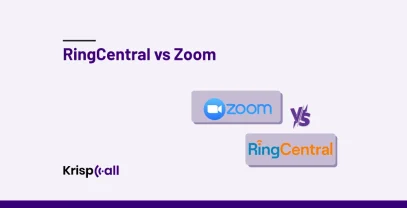Are you tired of manually dialing phone numbers and wasting precious time waiting for someone to answer?
In sales, where every second counts, call agents spend almost 50% of their time just calling the customer. However, only 10-15 minutes of every hour is actually spent on talking to potential customers. Agents waste a lot of time doing this, so choosing the right dialing method is essential for the sales team. That’s where a dialer comes into play.
A dialer is a tool that helps businesses make more calls in a shorter time. Not only does it eliminate the need for manual dialing, but it also increases the duration of conversations by 40% and reduces wait times by 98.3%.
In this article, we’ll explore the major differences between the manual way of dialing and the one that dials contacts without human intervention (predictive dialing).
🔑 KEY HIGHLIGHTS
- Manual dialing involves manually dialing numbers, while predictive dialing automatically dials numbers without agent involvement.
- Changing your manual dialing system to a predictive dialing system can increase your work productivity.
- Manual dialing is time-consuming, while predictive dialing saves agents time by automatically dialing numbers.
- Predictive dialing allows agents to make more calls in less time, increasing overall productivity.
- Predictive dialing eliminates human error associated with manual dialing, ensuring accurate connections.
Manual Dialing Vs. Predictive Dialing: Comparison Overivew
The major difference between manual and predictive dialing lies in its dialing process. The manual dialing process requires manually dialing each number while the predictive dialer automatically dials a pre-list of numbers without agent intervention.
Other differences between manual and predictive dialing are tabulated below:
| Based on | Manual Dialing | Predictive Dialing |
| Time | Manual dialing is a time-consuming method, as an agent has to dial a phone number simultaneously. | Predictive dialing saves time as it automatically dials numbers from a pre-defined contact list |
| Productivity | Most of the agent’s time is consumed by the number-dialing process, which can result in less productivity. | A predictive dialer helps agents make many calls in less time, which will increase overall productivity |
| Human errors | With manual dialing, Agents can sometimes mistakenly dial the wrong numbers. | An agent is connected to the correct number the software had pre-listed, so there will be no human error. |
| Call per hour | Agents spend 10-15 minutes of every hour actually talking to potential customers. | Predictive dialers can increase this talk time to 40-50 minutes per hour. |
| Consistency | Manual dialing completely depends on agents’ performance, and agents can often be inconsistent. | Predictive dialers provide a consistent calling pattern to agents. |
What is Manual Dialing?
Manual dialing is the process of dialing phone numbers manually, usually by typing numbers in a keypad by an agent. The agent dials phone numbers by hand, one at a time, instead of having a computer do it automatically. It requires picking up your phone, entering a number, and hitting the call button, just as you would with any regular phone call.

One good thing about the manual dialing method is that it offers more control over the dialing process and lets the user personalize each call as needed. However, it can be time-consuming compared to automated dialing methods, especially when dealing with significant calls.
How does Manual Dialing Work?
Manual dialing works by manually dialing the number, waiting for agents to pick up the call, and repeating the dialing process after each call concludes.
Here’s a breakdown of how manual dialers work:
- Enter phone numbers: The sales agent manually enters phone numbers, typically from a pre-existing list of clients or leads.
- Wait for connection: After dialing a number, the agent waits for the call to connect, sometimes involving waiting through busy signals or encountering incorrect numbers. There’s no guarantee of immediate connection with the client.
- Engage with clients: If the call connects successfully, the agent engages with the client, addressing their needs, answering questions, and possibly resolving any issues.
Advantages of Manual Dialing
Even though manual dialing is time-consuming and less efficient, it has various advantages. Many small businesses and large businesses still use manual dialing systems.
So, let’s check out Manual Dialing’s advantages,
- Detailed call information: As a universal truth, you remember the things you write more than those already there. Regarding manual dialing, agents have to dial a number individually; they can remember specific details about each call, such as the caller’s name, call status, notes, and reminders. This can help agents deal with customers’ problems as they remember all the details.
- Performance tracking: Manual dialing enables tracking agents’ performance through logging details, call records, and idle time. This data can help in evaluating individual and overall call center performance.
- Flexibility: Manual dialing offers greater flexibility in terms of which numbers to call and when to call them. Agents can prioritize calls based on factors like customer urgency or importance.
Disadvantages of Manual Dialing
Some of the disadvantages of manual dialing include:
- Low efficiency: Manual dialing is the least efficient method among dialing systems. Agents spend most of their time searching, dialing, and redialing numbers, which leaves them less time for an actual conversation with customers.
- Human error: As manual dialing requires agents to manually dial a number, they may dial the wrong number. As a result, they may call the wrong customer, wasting their valuable time.
- Limited Scalability: When a business has to make lots of calls, manual dialing gets harder. It takes too much time and effort. So, as the business grows, handling all those calls by hand becomes really tough. That’s why small businesses trying to grow might struggle with just manual dialing.
What is Predictive Dialing?
Predictive Dialing is an auto-dialing software that automatically dials multiple numbers simultaneously without human involvement and connects agents to live calls, skipping busy signals, voicemails, and unanswered calls.

Unlike the manual dialing system, where an agent had to dial a phone number manually, predictive dialing eliminates the dialing process so that agents spend more time speaking with customers and less time dialing. It is handy for call centers and businesses that need to make many outbound calls quickly and efficiently.
You may also like: Top 17 Sales Dialer Software to Automate Dialing Prospects in 2024
How does Predictive Dialing work?
Predictive dialing uses algorithms to predict when a sales agent will be available for the next call and dials multiple numbers at once.
Here’s how it typically works:
- Call list: The system is provided with a list of phone numbers to dial, typically from a database or CRM system.
- Dials numbers: The predictive dialer software automatically dials multiple numbers simultaneously.
- Predicts agent availability: It uses smart algorithms to analyze parameters like average call length, agent availability, and historical data to predict when an agent will be free.
- Call progress detection: As the system dials numbers, it listens for different call outcomes, such as busy signals, voicemails, or unanswered calls.
- Determine receiver information: When a call is answered, the predictive dialer uses algorithms to determine if a live person is on the other end of the line.
- Connect calls to agents: When the system detects a live call (i.e., answered by a person), it quickly connects it to an available agent.
Advantages of Predictive Dialing
Predictive dialing automates the process and optimizes call center operations by connecting agents with live calls. Besides this, there are several other benefits of predictive dialing:
- Time-saving: A predictive dialer uses algorithms to make a phone call automatically from a pre-set list. This feature can save your agents a significant amount of time spent on dialing numbers.
- Increased Productivity: A predictive dialer helps agents make many outbound calls in a shorter time, which will increase their overall productivity and sales.
- Improve Customer Service: In a predictive dialing system, agents won’t have to face the hassle of dialing a number individually. They can solely focus on their work, providing better service to customers.
- Scalability: Predictive dialers are scalable and can handle large volumes of calls efficiently, making them suitable for businesses of all sizes.
For more info, read this: Benefits of Predictive Dialer for Your Call Center
Disadvantages of Predictive Dialing
Here are some of the disadvantages of predictive dialing:
- Expensive: Predictive dialing software is costly. As a result, small businesses with limited budgets can’t afford it.
- Agent burnout: If the prediction isn’t made correctly about when and to whom to transfer the call, there is a high chance that one agent will get more calls than others. This will result in increased stress, fatigue, and decreased job satisfaction.
- Technical difficulty: As we all know, a predictive dialing system is a new and advanced feature with various technical aspects. Handling all these aspects can be difficult for an agent. It requires a higher level of technical expertise to set up and run.
- Increase abandon calls: There can be frequent abandoned calls when no agent is available to take the call; this can create frustration in customers.
Also Read: Auto Dialer Vs Predictive Dialer: What’s the Difference?
Challenges of Manual Dialing & How Predictive Dialing Resolves Them
Manual dialing, a traditional phone system, can have various challenges. However, with new and advanced features like predictive dialing, you can resolve all the problems of manual dialing.
Let’s talk thoroughly about the challenges of manual dialing and how predictive dialing resolves them;
Time-consuming
Agents spend a significant amount of time manually dialing phone numbers, which reduces the number of calls they can make in a given period. Predictive dialers solve this problem by automatically dialing a list of phone numbers, eliminating the need for agents to dial each number manually.
Expensive Maintenance Fees
Using manual dialing can be expensive due to maintenance costs for hardware and software. It also impacts your company’s overall budget and calling plans.
Predictive dialers don’t require expensive infrastructure and maintenance. For example, you can invest in a Cloud-Based Predictive dialer like KrispCall, which doesn’t require extra hardware and software.
Human Error
Sometimes, an agent misdials the phone number while manually dialing, which can lead to wasted time and missed connections.
However, in terms of predictive dialing, an agent doesn’t have to dial a number, in fact, Predictive dialers automatically dial a pre-listed number. It can reduce the risk of errors and also ensures accurate connections.
More Idle Time
Manual dialing involves agents individually making calls, which can be slow and inefficient. Most of the time, they miss out on potential sales opportunities and spend much time waiting between calls.
Predictive dialers automate the calling process by dialing multiple numbers at once, filtering out things like busy signals and wrong numbers, and only connecting calls answered by live people to agents.
Low Call Accuracy
Manual dialing often compromises call accuracy due to misdialed numbers and disconnected calls. This can result in reduced efficiency and waste agents’ time.
Predictive dialers use algorithms to filter out non-productive calls before connecting them to agents, ensuring higher calling accuracy and maximizing overall productivity.
Conclusion
The method of dialing plays a significant role in the efficiency and productivity of sales teams. Even though manual dialing offers control and personalization, it is often inefficient and time-consuming. On the other hand, predictive dialing automates the dialing process, saving time, increasing productivity, and improving call accuracy.
Hence, switching from manual dialing to predictive dialing can boost productivity. Moreover, agents can communicate freely without worrying about dialing and build better connections with customers.
If you are looking for reliable auto dialer software, we recommend you try KrispCall. KrispCall’s auto dialer is designed to enhance dialing capabilities within a cloud-based setup and offer easy integration with other business tools and software. Moreover, it offers several other call management features like call blocking, call monitoring, call reporting and analytics, and many more.





